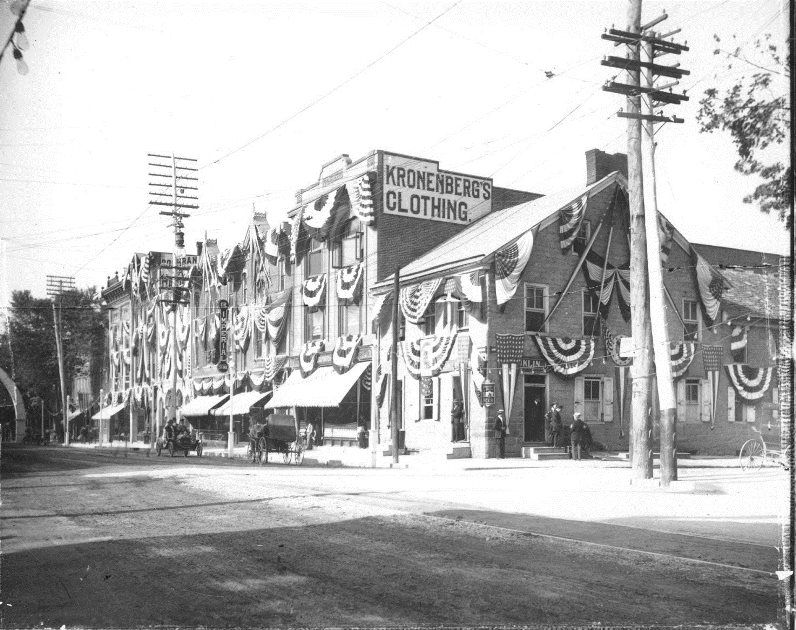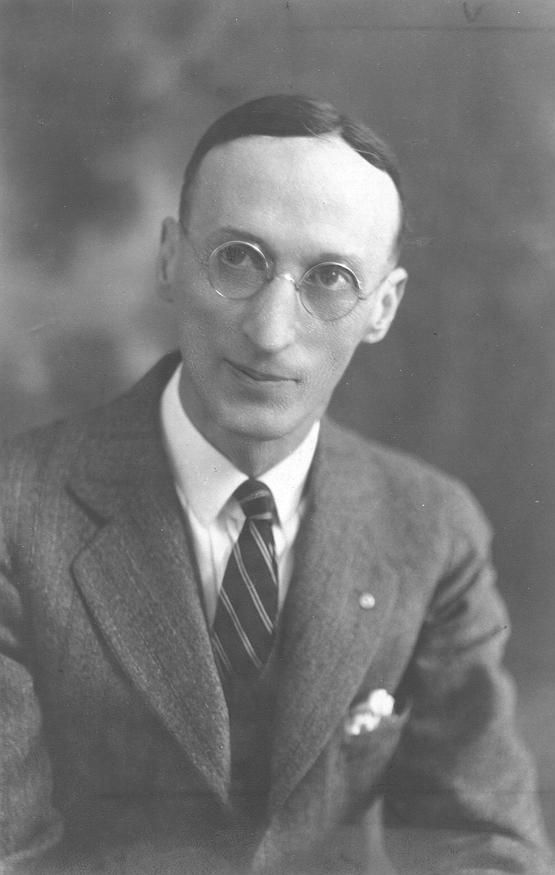Mail Delivery in the 18th Century
When Post Masters received letters, they listed the names in the newspapers of those to whom the letters were addressed. If the letters were not picked up by a specified date, they went to the Dead Letter Office.



Top: Buildings in the first block of South Hanover Street, west side--just south of the Court House. Franklin House Hotel is on the corner of Courthouse Avenue with Kronenberg Clothing Store next door. This photo is taken after Kroneberg's added a third story.The buildings are decorated with bunting for Old Home Week (01071A#02);
Middle: The Kronenberg building on fire, with a large crowd watching the firemen spraying water on the building (30-5A-02);
Bottom: William M. Kronenberg (16-22-01).
Samuel Kronenberg, an entrepreneur of inexpensive yet fashionable men's clothing, immigrated from Germany to the United States in the early 1860s.1 The outbreak of the Civil War led to a blockade around New York, forcing Kronenberg to enter the country in Savannah, Georgia.2 In Georgia he was forced into the Confederate Army, where he fought until he was given a Citizen's Pass to travel by the Provost Marshal General's office in 1864.3 Using the pass, Kronenberg moved to Harrisburg, Pennsylvania, where he worked at a relative’s clothing store until he meet his wife, Henietta Schweitzer in 1866.4 Kronenberg realized he would not be able to support a family working at this store, and decided to move to Cumberland County in March of 1866 to open a clothing store of his own.5 This small store on the corner of Hanover and Louther was called “Cheap John's,” a nickname Kronenberg affectionately called himself.6 In 1870, the store moved to South Hanover Street where it was renamed “Kronenberg’s,” a name that became a legacy in Carlisle.7
After Samuel Kronenberg’s death in 1893, his sons William and Edward took over the store, bringing it into the 20th century.8 In 1905 they bought Franklin House, a local tavern, and the adjoining building on South Hanover Street.9 This adjoining building became the new location of the Kronenberg's store, set between the courthouse, market house, and other local businesses, making it a popular spot for locals.10 In 1916, just 11 years after moving locations, the brothers built the largest and most modern building in Carlisle.11 Standing 3 stories tall, the brick, wood, and glass building housed a store, offices, and apartments.12 Unfortunately, the building burnt down on December 7, 1929, leaving $285,000 in damages.13 A year later, the new, fireproof building opened under the direction of Edward Kronenberg.
When William and Edward became partners, the store implemented a new policy of civic mindedness. During this time the store windows were used as community displays, advertising for groups like the Red Cross and Carlisle High School Band.14 Inside the store was a display case selling commemorative items, such as plates and mugs, from the Carlisle Civic Club.15 The store remained a family business after the deaths of William and Edward Kronenberg in 1927 and 1946, respectively.16 Edward's wife, Helen Tomlinson Kronenberg assumed the position of head of the corporation following his death.17 Following her death, Bearden Kunkel, married to one of the Kronenberg daughters, become president of the store.18 Over the years various family members have worked part time or full time in the store, as salesmen, secretaries, office managers, and more.19
Kronenberg's celebrated its 100th year anniversary in October of 1966, acknowledging the people of Carlisle for the store's success.20 The clothing store was a favorite among residents, for its cheap and fashionable clothing as well as its community engagement. Local author Lois Lowry recalled one of her favorite flannel shirts coming from Kronenberg’s.21 Samuel Kronenberg's discount clothing store started as a way to support a household, but transformed turned into valued family business and community asset for over a hundred years.
When Post Masters received letters, they listed the names in the newspapers of those to whom the letters were addressed. If the letters were not picked up by a specified date, they went to the Dead Letter Office.
[1] Carlisle Guide, Carlisle, 1969.
[2] Edward Stuart Kronenberg, “The Kronenberg Building,” in Lamberton and Hamilton Library Association Prize Essays, Vol. 4, 15.
[3] Carlisle Guide, Carlisle, 1969.
[4] Paul D. Hoch, “Kronenberg's,” Carlisle History and Lore: Its People, Places and Stories, March 15, 1975, 8.
[5] Edward Stuart Kronenberg, “The Kronenberg Building,” in Lamberton and Hamilton Library Association Prize Essays, Vol. 4, 15-16.
[6] Paul D. Hoch, “Kronenberg's,” Carlisle History and Lore: Its People, Places and Stories, March 15, 1975, 8.
[7] Edward Stuart Kronenberg, “The Kronenberg Building,” in Lamberton and Hamilton Library Association Prize Essays, Vol. 4, 16.
[8] Carlisle Guide, Carlisle, 1969.
[9] Paul D. Hoch, “Kronenberg's,” Carlisle History and Lore: Its People, Places and Stories, March 15, 1975, 8.
[10] Ibid.
[11] Edward Stuart Kronenberg, “The Kronenberg Building,” in Lamberton and Hamilton Library Association Prize Essays, Vol. 4, 16.
[12] Carlisle Guide, Carlisle, 1969.
[13] Edward Stuart Kronenberg, “The Kronenberg Building,” in Lamberton and Hamilton Library Association Prize Essays, Vol. 4, 16.
[14] Carlisle Guide, Carlisle, 1969.
[15] Paul D. Hoch, “Kronenberg's,” Carlisle History and Lore: Its People, Places and Stories, March 15, 1975, 8.
[16] Carlisle Guide, Carlisle, 1969.
[17] Ibid.
[18] Ibid.
[19] Ibid.
[20] Ibid.
[21] Lois Lowry, Looking Back: A book of memories (Boston: Houghton Mifflin Company, 1998), 81.